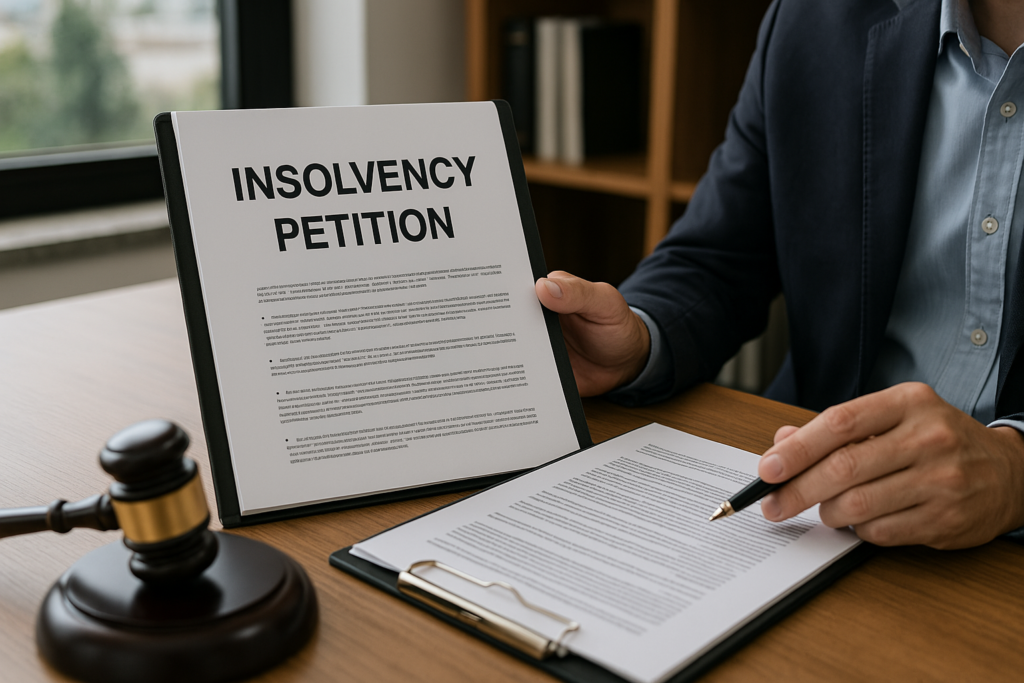Filing an insolvency petition under the Insolvency and Bankruptcy Code (IBC), 2016, has become a significant legal recourse for resolving corporate financial distress. If you want to file an Insolvency Petition in Chandigarh, understanding the procedure before the National Company Law Tribunal (NCLT) Chandigarh is crucial. File an Insolvency Petition in Chandigarh NCLT Under IBC to begin a structured legal process for debt resolution or recovery. This guide provides a detailed breakdown of how to file an insolvency petition, referencing the applicable Acts and sections under Indian law. It is designed for both clients and law students seeking in-depth procedural and legal clarity.
Introduction
The IBC, 2016, is a comprehensive legislation that consolidates and amends laws relating to insolvency resolution of corporate entities, partnership firms, and individuals. It provides a time-bound mechanism to resolve insolvency, ensuring creditor protection and business continuity.
For those operating or residing in Northern India, the Chandigarh Bench of the NCLT plays a pivotal role. Legal professionals such as corporate lawyers in Chandigarh, NCLT lawyers in Chandigarh, and high court advocates in Chandigarh often deal with insolvency matters filed at this forum.
Understanding the IBC Framework
History and Objective of the IBC, 2016
The IBC was enacted to provide a unified framework for insolvency resolution. Before the IBC, creditors had to rely on fragmented laws like the Companies Act, 1956, SARFAESI Act, and the Sick Industrial Companies Act (SICA), which often led to prolonged litigation.
Key Sections Relevant to Insolvency Proceedings
Section 6: Who may initiate insolvency?
This section allows financial creditors, operational creditors, and the corporate debtor itself to initiate insolvency proceedings.
Section 7: Financial Creditor’s Petition
Financial creditors can initiate proceedings upon default, supported by evidence. The application must be filed in Form 1 along with the required documents.
Section 8 & 9: Operational Creditor’s Petition
Operational creditors must first issue a demand notice under Section 8. If the debtor fails to repay or dispute the claim within 10 days, a petition under Section 9 can be filed.
Section 10: Corporate Debtor’s Petition
Corporate debtors themselves can initiate insolvency voluntarily if they have defaulted on payments.
Section 12A: Withdrawal of Application
Permits withdrawal of an insolvency application before admission, provided 90% of the Committee of Creditors (CoC) agree.
Section 33: Initiation of Liquidation
If no resolution is reached within the prescribed timeframe, liquidation proceedings begin.
Article 137 of the Limitation Act, 1963
The limitation period for filing an insolvency petition is three years from the date of default.
Types of Insolvency Applicants
Financial Creditors
Banks, NBFCs, and financial institutions that have lent money fall into this category.
Operational Creditors
Suppliers, service providers, and employees with unpaid dues can also initiate proceedings.
Corporate Debtors (Voluntary Insolvency)
Businesses that have defaulted on obligations may self-initiate insolvency to restructure debts.
Homebuyers as Creditors
As per Supreme Court rulings and amendments, homebuyers are considered financial creditors and can file petitions under Section 7.
Filing an Insolvency Petition at NCLT Chandigarh
Step 1: Choose the Right Legal Category
Identifying whether you are a financial creditor, operational creditor, or the corporate debtor will determine the form, fee, and process.
Step 2: Drafting the Application
The application should comply with prescribed forms (Form 1, Form 5, etc.) and include:
- Details of default
- Proof of claim
- Corporate debtor’s financial information
Step 3: Collation of Documents
Commonly required documents:
- Loan agreements or invoices
- Bank statements
- Demand notice (for operational creditors)
- Default record from information utility (if available)
Step 4: Payment of Prescribed Fees
The fee varies based on the type of petitioner. Fees must be paid online through the MCA portal.
Step 5: Filing Through NCLT e-Portal
Applications must be submitted electronically through the NCLT e-filing portal and physically in the NCLT Chandigarh registry.
Step 6: Admission and Hearing by NCLT Bench Chandigarh
The NCLT examines:
- Existence of default
- Completeness of application
- Any pending disputes (in operational creditor cases)
Step 7: Appointment of Interim Resolution Professional (IRP)
Upon admission, an IRP is appointed to manage the affairs of the debtor and form a Committee of Creditors (CoC).
Role of NCLT Chandigarh
Territorial Jurisdiction and Importance
The NCLT Chandigarh Bench has jurisdiction over companies registered in Punjab, Haryana, Himachal Pradesh, and the Union Territory of Chandigarh.
Role of NCLT in Corporate Insolvency Resolution Process (CIRP)
The NCLT oversees the entire CIRP, ensures timely resolution, and approves or rejects resolution plans.
Coordination with Insolvency and Bankruptcy Board of India (IBBI)
The NCLT works alongside the IBBI to maintain the integrity of the process.
Timeframes Under the IBC
14 Days: Admission of Application
Applications must be either admitted or rejected within 14 days of filing.
180 Days: Resolution Period
The CIRP must be completed within 180 days, extendable by another 90 days with approval.
Maximum 330 Days
Including extensions and legal proceedings, the total period cannot exceed 330 days.
Common Mistakes to Avoid
Incomplete Documentation
Missing bank records or unsigned contracts can delay or derail the petition.
Filing under the Wrong Section
For example, operational creditors incorrectly filing under Section 7.
Delay in Initiating Claims
Delays beyond the limitation period are barred unless justified.
Lack of Evidence for Default
Failure to prove default or the existence of a dispute can lead to dismissal.
Legal Remedies After Rejection
Appeal Under Section 61 – NCLAT
If the NCLT rejects the petition, an appeal can be filed within 30 days before the National Company Law Appellate Tribunal (NCLAT).
High Court Writ under Article 226/227
High court lawyers in Chandigarh can approach the High Court for violation of natural justice or jurisdictional error.
Supreme Court under Article 136
In exceptional cases, a Special Leave Petition (SLP) can be filed before the Supreme Court.
Filing an insolvency petition in Chandigarh before the NCLT is a legal remedy available to creditors and debtors alike under the IBC. It is essential to follow the correct procedure, ensure legal documentation is in order, and act within statutory timelines. Whether you’re a corporate creditor, operational vendor, or company director, understanding your rights and responsibilities under IBC is the first step toward a successful resolution.
FAQs on Insolvency Petition in Chandigarh
- What is the role of an Interim Resolution Professional (IRP)?
An IRP manages the affairs of the debtor post-admission of the petition. They form the Committee of Creditors and take over the management to preserve asset value. - Can an individual file for insolvency under IBC?
Yes. Individuals and partnership firms can initiate insolvency proceedings under Part III of the IBC. However, provisions for individuals are not yet fully notified in all jurisdictions. - What is the filing fee for an insolvency petition at NCLT Chandigarh?
Filing fees range from ₹2,000 to ₹25,000 depending on the type of applicant. Additional costs include documentation, professional fees, and e-filing charges. - Is it mandatory to hire a lawyer for filing IBC petitions?
While not mandatory, it is strongly recommended. Professional legal help ensures compliance with procedural law, especially when represented by experienced corporate advocates in Chandigarh or NCLT lawyers in Chandigarh. - What happens after the petition is admitted by NCLT?
Upon admission, the insolvency process begins with the appointment of an IRP. A public announcement is made, claims are verified, and the CoC is formed to proceed with resolution.

